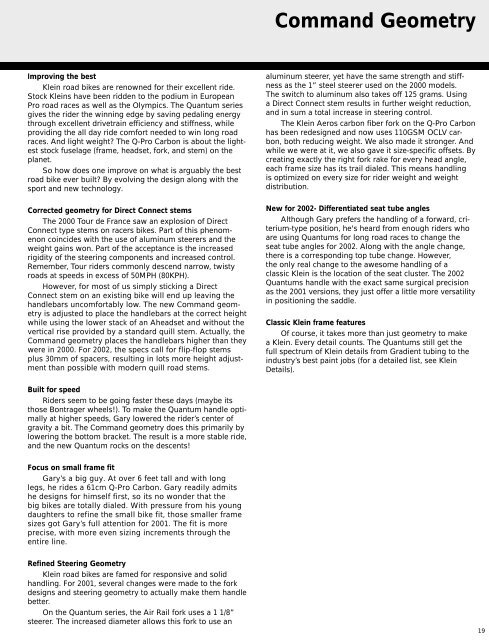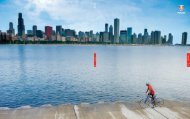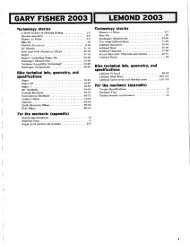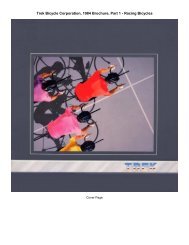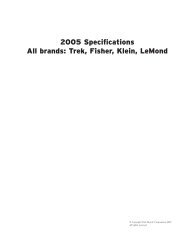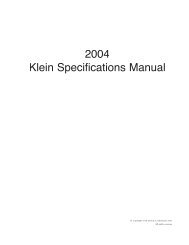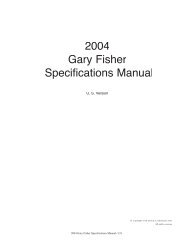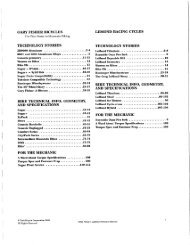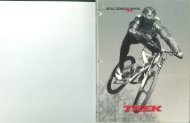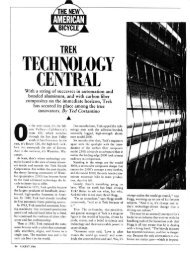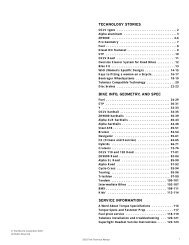2002 Klein Technical Manual - Vintage Trek
2002 Klein Technical Manual - Vintage Trek
2002 Klein Technical Manual - Vintage Trek
You also want an ePaper? Increase the reach of your titles
YUMPU automatically turns print PDFs into web optimized ePapers that Google loves.
Improving the best<br />
<strong>Klein</strong> road bikes are renowned for their excellent ride.<br />
Stock <strong>Klein</strong>s have been ridden to the podium in European<br />
Pro road races as well as the Olympics. The Quantum series<br />
gives the rider the winning edge by saving pedaling energy<br />
through excellent drivetrain efficiency and stiffness, while<br />
providing the all day ride comfort needed to win long road<br />
races. And light weight? The Q-Pro Carbon is about the lightest<br />
stock fuselage (frame, headset, fork, and stem) on the<br />
planet.<br />
So how does one improve on what is arguably the best<br />
road bike ever built? By evolving the design along with the<br />
sport and new technology.<br />
Corrected geometry for Direct Connect stems<br />
The 2000 Tour de France saw an explosion of Direct<br />
Connect type stems on racers bikes. Part of this phenomenon<br />
coincides with the use of aluminum steerers and the<br />
weight gains won. Part of the acceptance is the increased<br />
rigidity of the steering components and increased control.<br />
Remember, Tour riders commonly descend narrow, twisty<br />
roads at speeds in excess of 50MPH (80KPH).<br />
However, for most of us simply sticking a Direct<br />
Connect stem on an existing bike will end up leaving the<br />
handlebars uncomfortably low. The new Command geometry<br />
is adjusted to place the handlebars at the correct height<br />
while using the lower stack of an Aheadset and without the<br />
vertical rise provided by a standard quill stem. Actually, the<br />
Command geometry places the handlebars higher than they<br />
were in 2000. For <strong>2002</strong>, the specs call for flip-flop stems<br />
plus 30mm of spacers, resulting in lots more height adjustment<br />
than possible with modern quill road stems.<br />
Built for speed<br />
Riders seem to be going faster these days (maybe its<br />
those Bontrager wheels!). To make the Quantum handle optimally<br />
at higher speeds, Gary lowered the rider’s center of<br />
gravity a bit. The Command geometry does this primarily by<br />
lowering the bottom bracket. The result is a more stable ride,<br />
and the new Quantum rocks on the descents!<br />
Focus on small frame fit<br />
Gary’s a big guy. At over 6 feet tall and with long<br />
legs, he rides a 61cm Q-Pro Carbon. Gary readily admits<br />
he designs for himself first, so its no wonder that the<br />
big bikes are totally dialed. With pressure from his young<br />
daughters to refine the small bike fit, those smaller frame<br />
sizes got Gary’s full attention for 2001. The fit is more<br />
precise, with more even sizing increments through the<br />
entire line.<br />
Refined Steering Geometry<br />
<strong>Klein</strong> road bikes are famed for responsive and solid<br />
handling. For 2001, several changes were made to the fork<br />
designs and steering geometry to actually make them handle<br />
better.<br />
On the Quantum series, the Air Rail fork uses a 1 1/8”<br />
steerer. The increased diameter allows this fork to use an<br />
Command Geometry<br />
aluminum steerer, yet have the same strength and stiffness<br />
as the 1” steel steerer used on the 2000 models.<br />
The switch to aluminum also takes off 125 grams. Using<br />
a Direct Connect stem results in further weight reduction,<br />
and in sum a total increase in steering control.<br />
The <strong>Klein</strong> Aeros carbon fiber fork on the Q-Pro Carbon<br />
has been redesigned and now uses 110GSM OCLV carbon,<br />
both reducing weight. We also made it stronger. And<br />
while we were at it, we also gave it size-specific offsets. By<br />
creating exactly the right fork rake for every head angle,<br />
each frame size has its trail dialed. This means handling<br />
is optimized on every size for rider weight and weight<br />
distribution.<br />
New for <strong>2002</strong>- Differentiated seat tube angles<br />
Although Gary prefers the handling of a forward, criterium-type<br />
position, he's heard from enough riders who<br />
are using Quantums for long road races to change the<br />
seat tube angles for <strong>2002</strong>. Along with the angle change,<br />
there is a corresponding top tube change. However,<br />
the only real change to the awesome handling of a<br />
classic <strong>Klein</strong> is the location of the seat cluster. The <strong>2002</strong><br />
Quantums handle with the exact same surgical precision<br />
as the 2001 versions, they just offer a little more versatility<br />
in positioning the saddle.<br />
Classic <strong>Klein</strong> frame features<br />
Of course, it takes more than just geometry to make<br />
a <strong>Klein</strong>. Every detail counts. The Quantums still get the<br />
full spectrum of <strong>Klein</strong> details from Gradient tubing to the<br />
industry’s best paint jobs (for a detailed list, see <strong>Klein</strong><br />
Details).<br />
19


